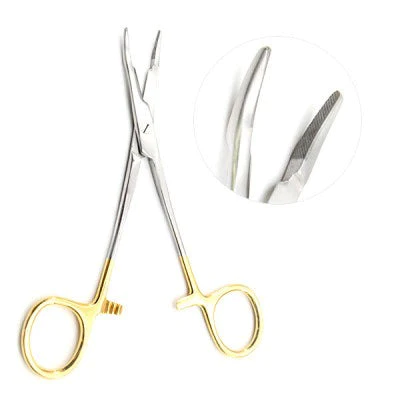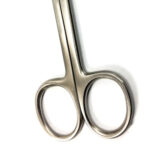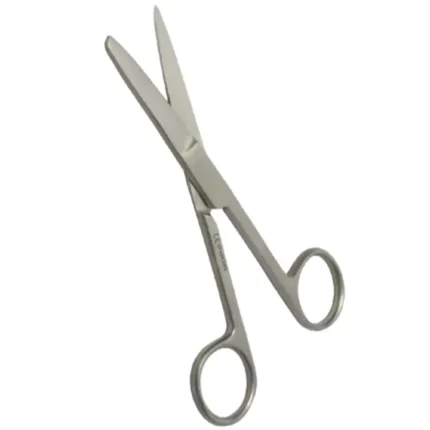Medical Operation Surgical Instrument operating Scissor Stainless Steel
The Medical Operation Surgical Instrument Operating Scissor is a high-quality, stainless steel tool designed for precision and durability in surgical procedures.Made from corrosion-resistant stainless steel, they ensure long-lasting performance and easy sterilization.
Categories: GENERAL DRESSING AND TISSUE FORCEPS, GENERAL SURGERY, GENERAL SURGERY SCISSORS
Tags: HealthcareSupplies, HighQualityScissors, MedicalGradeSteel, MedicalInstruments, MedicalSurgicalTools, OperatingRoomTools, OperatingScissors, PrecisionSurgeryTools, ProfessionalSurgicalInstruments, StainlessSteelInstruments, SterileInstruments, SurgicalEquipment, SurgicalInstruments, SurgicalScissors, SurgicalSupplies
Description
Medical Operation Surgical Instrument Operating Scissors: Precision and Durability
The Medical Operation Surgical Instrument Operating Scissors are expertly designed tools used in a variety of medical procedures. Constructed from premium stainless steel, these scissors are known for their precision, reliability, and exceptional durability. Whether cutting sutures, tissues, or medical materials, they deliver consistent performance, making them a staple in any surgical toolkit.
Key Features of Medical Operation Surgical Instrument Operating Scissors
- High-Grade Stainless Steel Construction
These scissors are manufactured from surgical–grade stainless steel, ensuring resistance to corrosion, rust, and wear. Their robust construction allows for repeated sterilizations without compromising performance. - Sharp and Precise Blades
The finely honed blades are designed for sharp and accurate cutting, reducing the effort required and minimizing the risk of tissue damage during procedures. - Straight and Curved Options
Operating scissors are available in straight or curved designs, catering to specific needs in both surface and deep surgical fields. - Ergonomic Handles
Designed with user comfort in mind, the ergonomic handles provide a secure grip, enhancing control and reducing hand fatigue during extended use. - Versatility in Sizes
Available in a variety of lengths, these scissors can accommodate a range of surgical applications, from intricate operations to more robust cutting needs.
Applications of Operating Scissors
The Medical Operation Surgical Instrument Operating Scissors are highly versatile, making them suitable for a broad range of applications:
- General Surgery: Used for cutting sutures, tissues, and surgical materials with precision.
- Plastic Surgery: Essential for shaping and excising tissues during cosmetic or reconstructive procedures.
- Cardiothoracic Surgery: Ideal for delicate cuts and precise trimming in thoracic and cardiac operations.
- Gynecological Procedures: Frequently used in cesarean sections, episiotomies, and other gynecological surgeries.
- Veterinary Applications: Provides precise cutting solutions in animal surgeries.
- First Aid and Trauma Care: Effective for cutting bandages, clothing, and other materials in emergency scenarios.
Types of Operating Scissors
- Straight Operating Scissors
Straight scissors are designed for cutting on flat surfaces or materials such as sutures, bandages, or thin tissues. Their straightforward design makes them a go-to tool for surface-level work. - Curved Operating Scissors
Curved scissors are ideal for cutting deeper tissues or navigating around structures in confined surgical fields. They provide greater control and access in complex scenarios.
Benefits of Stainless Steel Operating Scissors
- Long-Lasting Durability
The premium stainless steel construction ensures that the scissors remain reliable even with frequent use and sterilization. - Precision and Efficiency
The sharp blades make every cut clean and precise, improving surgical outcomes and reducing the risk of errors. - Ergonomic Design for Comfort
Lightweight and ergonomically designed, these scissors enhance surgeon comfort and minimize hand strain during lengthy procedures. - Corrosion Resistance
The stainless steel material resists rust and corrosion, maintaining its integrity even under challenging conditions. - Cost-Effective Tool
With their long-lasting performance, stainless steel scissors represent a cost-effective investment for medical professionals.
Care and Maintenance of Operating Scissors
Proper care is essential to maintain the effectiveness and longevity of your surgical scissors. Follow these guidelines:
- Cleaning After Use
Rinse the scissors thoroughly after each procedure to remove biological material. Use a soft brush and a neutral detergent to clean the blades and hinges. - Sterilization
Ensure the scissors are sterilized according to medical standards. Autoclaves and chemical sterilization methods are both suitable for stainless steel instruments. - Inspection and Sharpening
Regularly inspect the scissors for signs of wear, including dullness or misalignment of the blades. Sharpen or replace them as needed. - Storage
Store the scissors in a dry, clean environment. Use protective cases or organizers to prevent damage to the blades and ensure easy accessibility.
Frequently Asked Questions (FAQs)
Q: Are these scissors suitable for non-surgical uses?
A: While primarily designed for medical use, their precision and durability make them suitable for other professional applications such as crafting or laboratory work.
Q: Can they handle heavy-duty cutting tasks?
A: Yes, the sharp blades and robust construction make them capable of cutting through tough materials like thick sutures and dense tissues.
Q: How do I maintain the sharpness of the blades?
A: Clean and dry the scissors immediately after use and store them in a protective case. Regular sharpening can help maintain their cutting efficiency.
Conclusion
The Medical Operation Surgical Instrument Operating Scissors Stainless Steel combine precision, durability, and ergonomic design to meet the high standards of medical professionals. From delicate tissue handling to cutting robust materials, these scissors are versatile, reliable, and essential for any surgical or medical setting. With proper care, they provide long-lasting value, ensuring consistent performance in even the most demanding situations.
Reviews (0)
Be the first to review “Medical Operation Surgical Instrument operating Scissor Stainless Steel” Cancel reply
Shipping & Delivery


MAECENAS IACULIS
Vestibulum curae torquent diam diam commodo parturient penatibus nunc dui adipiscing convallis bulum parturient suspendisse parturient a.Parturient in parturient scelerisque nibh lectus quam a natoque adipiscing a vestibulum hendrerit et pharetra fames nunc natoque dui.
ADIPISCING CONVALLIS BULUM
- Vestibulum penatibus nunc dui adipiscing convallis bulum parturient suspendisse.
- Abitur parturient praesent lectus quam a natoque adipiscing a vestibulum hendre.
- Diam parturient dictumst parturient scelerisque nibh lectus.
Scelerisque adipiscing bibendum sem vestibulum et in a a a purus lectus faucibus lobortis tincidunt purus lectus nisl class eros.Condimentum a et ullamcorper dictumst mus et tristique elementum nam inceptos hac parturient scelerisque vestibulum amet elit ut volutpat.
Related products
Blunt Dressing Scissor, 5.5 Inch, 1.45 Ounce
Busch Umbilical Scissors 16cm
Rizbain Surgical provides a wide variety of surgical scissors. One of which is Busch Umbilical Scissors. These are gynecological scissors used to grasp the umbilical cord after birth. Their strategic angle makes them an ideal tool for the dissecting procedure. These surgical scissors have an ergonomic design for better control. They consist of a pair of premium-grade sharped blades with stainless steel material, joined with the pin. Their premium quality blades make them different from any other brand of surgical scissors.
Cooley Suction Tube 35cm
GENERAL SUCTION TUBES, GENERAL SURGERY SCISSORS, ENT INSTRUMENTS, MICRO LARYNGOLOGY INSTRUMENTS, PLASTIC SURGERY INSTRUMENTS, SUCTION TUBES
Rizbain Surgical is the best leading Manufacturer and Supplier of Excellent Quality Suction Tubes, such as Frazier Suction Tubes, Frazier (Fergusson) Suction Tubes, Pool Suction Tubes, Yankauer Suction Tubes, Cooley Suction Tubes, Adson Suction Tubes. All these Instruments are made with Surgical Graded Steel as per International standards.
Deaver Operating Scissors 14cm
Rizbain surgical provides a wide variety of surgical scissors. One of which is Busch Umbilical Scissors. These are gynecological scissors used to grasp the umbilical cord after birth. Their strategic angle makes them an ideal tool for the dissecting procedure. These surgical scissors have an ergonomic design for better control. They consist of a pair of premium-grade sharped blades with stainless steel material, joined with the pin. Their premium quality blades make them different from any other brand of surgical scissors.
Debakey Potts Smith Scissors
Rizbain Surgical provides a wide variety of surgical scissors. One of which is Busch Umbilical Scissors. These are gynecological scissors used to grasp the umbilical cord after birth. Their strategic angle makes them an ideal tool for the dissecting procedure. These surgical scissors have an ergonomic design for better control. They consist of a pair of premium-grade sharped blades with stainless steel material, joined with the pin. Their premium quality blades make them different from any other brand of surgical scissors.
Scalpel Handle No. 3 (#3)
GENERAL SURGERY, GENERAL KNIFE AND HANDLES, GENERAL SURGERY INSTRUMENTS SET LIST, PLASTIC SURGERY INSTRUMENTS, KNIFE AND HANDLES, PLASTIC SURGERY MEDICAL INSTRUMENTS
Castleimpexx Offering High-quality Scalpel Handles, Such as Dissecting Knife, Scalpel Handle Angled 3L, Scalpel Handle No. 3 (#3), Scalpel Handle Standard #4, Scalpel Handle Standard Double Ended, Scalpel Handle Strait 3L, Scalpel Handle with Celebrations No. 03 and Scalpel, Round Handle, 16cm, you can See our Scalpel Handles and other products on our Videos
Stainless Steel Curved Scissors Round Pointed Head Surgical Scissors
Standard hair dressing scissors 16 cm made of superior quality stainless steel
The Standard Hair Dressing Scissors (16 cm) are crafted from superior quality stainless steel, designed to deliver precision and durability for hair cutting tasks. With sharp, finely aligned blades, these scissors ensure smooth, clean cuts, enhancing control and ease for professional hairdressers and stylists.

































Reviews
There are no reviews yet.